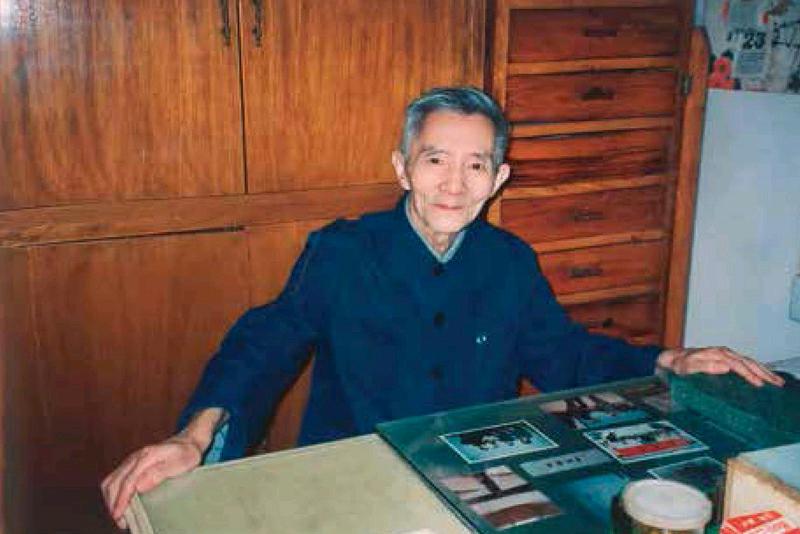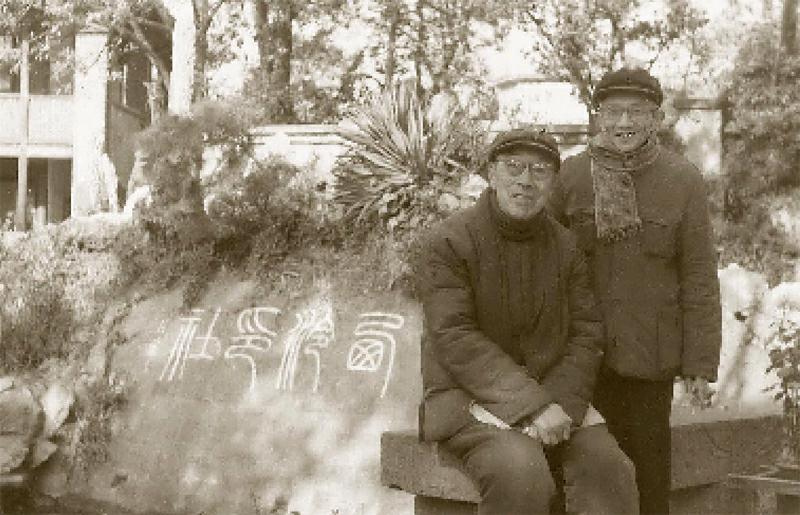黃涌泉:古書畫鑒定家的藝術緣
朱明堯
2017年夏,浙江文博界舉辦了紀念本省已故著名古書畫鑒定家、省博物館資深研究員黃涌泉先生的專題活動。在浙江博物館展出了他的生平業績和研究成果圖片及翰墨作品,舉行了專題座談會,并在《金石書畫》和《西泠藝叢》等專業刊物發表了多篇弘揚和研究黃老的文章。
黃涌泉立足于實踐及研究,為浙江的文物鑒定作出了巨大貢獻,并有許多學術成果傳世。幾十年來,全省各地經他過目的書畫作品多達十多萬件,鑒定出宋朝至清朝的珍貴字畫有上千件之多。在此基礎上,他撰寫發表了許多學術論文,并編輯出版專集,如《八大山人雙鳥圖考辨》、《書畫鑒定淺談》、《吳鎮繪畫作品真偽考辨》、《杭州元代石窟藝術》、《浙江歷代畫家作品選集》(與王伯敏合編)、《浙江近代書畫選集》等,尤其是他編的《陳洪綬年譜》深受國內外學者推崇。他的學術視野和鑒定實踐立足于浙江,延伸于華東,并影響于國內的文博界。
黃涌泉涉足浙江古書畫鑒定后,幾乎跑遍了浙江的東南西北。上世紀七十年代后期,他帶領幾位門生先后赴嘉興、湖州、寧波、紹興、臺州和舟山等地區的縣市,鑒定古書畫數以萬計,悉心研究,從中搶救出了重要書畫和古籍一千余件,定為不同級別的文物,例如,1973年他在紹興的嵊州進行鑒定時,從一堆當時“抄查”來而被遺棄的廢舊書畫中發現了一幅《蘇武牧羊圖》。這幅作品被鑒定為明代著名浙派畫家、號稱酒仙的陳子和所作(陳原籍為福建浦城),存世作品極為罕見。
當代中國古書畫鑒定泰斗、故宮博物院資深研究員徐邦達先生(浙江海寧人1911—2012),于眾多古書畫鑒定的門生中自認為“最得意”的一位是浙江博物館資深研究員、古書畫鑒定名家黃涌泉先生(浙江嘉善人,已在2003年作古,終年78歲)。
紀念黃涌泉先生,我檢看了徐老致我的信函12通、詩文墨寶3件、黃老致函2件及黃老應我之約請而撰的5000字遺文(黃老學生周永良之綜合整理稿),探索疏理了黃老在藝術鑒定的長途跋涉中,與他的業師徐邦達之虛心求教和誠意往來,不禁想起了徐、黃師生情誼之佚事。
早在1997年夏,徐老曾客居南京金陵飯店二月余,時在為他于當年7月7日舉辦的書畫個展創作作品及鑒定當地藏品。黃涌泉過往,晤談甚歡。徐老有感,寫下了贈黃先生六首七絕詩,詩之小序中記敘了兩人的情誼。
徐邦達和黃涌泉兩位先后走上國家、地方的古書畫鑒定之崗,自然源于他們早年的藝術喜好和功底,當時客觀上也是新中國成立初期文物事業復興的需要。徐老應鄭振鐸之召,1950年先至國家文物局后轉故宮博物院;黃涌泉則是在1953年8月調到浙江省文物管理局(后轉省博物館)。
徐、黃師生緣啟于1955年。當年7月,黃涌泉奉派赴京參加文化部、中國科學院、北京大學聯合舉辦的“第四屆考古人員訓練班”。到達北京辦好報到手續后,他便懷揣著沙孟海先生的推薦信,去故宮博物院拜訪徐邦達先生。那時他不過二十多歲,參加文物工作才兩年,而徐先生已是蜚聲文博界的書畫鑒定專家。他站在傳達室旁,內心未免有些緊張。只見徐先生緩步出來,他迎上去呈上沙老便函,徐看了以后,面帶微笑將他引至辦公室敘談,談得很契合。那一次黃涌泉在北京兩個多月,培訓班課余時間,就到故宮皇極殿,寧壽宮及東西廡仔細參觀繪畫館數以百計的古代珍品,看不懂的就向徐先生請教。
自此以后,黃涌泉與徐先生多有交往。1962年4月,徐先生到杭州參加有關“中國繪畫史”的研討會。早在1954年故宮繪畫館開放不久,徐先生就發表了《從繪畫館陳列品看我國繪畫的發展史》一文,徐先生在這次杭州會議上,更加詳盡地表述了自己的論點。會議結束后,徐先生應邀為浙江美術學院圖畫系作鑒定書畫的學術報告,黃涌泉與學生們一起聽課做筆記,當時的記錄至今還保存著。
1979年9月,徐先生自北京飛抵杭州,故宮楊伯達先生結伴而至,徐先生這時已年近七十了,依然精神矍鑠,鶴發松姿,黃先生安排他們住到西子湖畔新新飯店。次日,沙孟海先生與黃涌泉在杭州酒家宴請徐先生。這次徐老來浙,鑒定了浙江博物館書畫數十件,又去杭州市文管會等有關單位鑒定所藏書畫。徐先生還常領楊新和黃先生到杭州橫紫城巷余任天先生家,鑒定他的書畫藏品,得見明黃克晦《金陵八景圖冊》及黃道周《草書軸》。在杭州期間,黃涌泉又向徐師請教有關明代院畫研究問題。徐先生認為明朝宮庭繪畫值得進一步研究,隨手取出一本故宮業務部書畫組編的《明代院體浙派繪畫資料》油印本借給黃看。黃先生喜閱數日才歸還。徐先生一行離開杭州赴紹興逗留兩天,然后去寧波天一閣考察、鑒定書畫,慧眼識珠,鑒定中發現了元四家之一吳鎮《雙樹圖》軸,定為吳鎮中年的作品。
1983年11月,徐先生至杭州參加西泠印社建社八十周年紀念活動,11月3日上午在學術交流會上,宣讀他的《略談唐宋畫所鈐的公私印記》論文。數天時間中,黃涌泉始終相伴著徐老。同年12月,黃涌泉應召偕學生周永良赴福建,隨侍徐先生鑒定書畫。走訪了福州、泉州、廈門等地,先后到福建省博物館、福州市文管會、泉州市文管會、廈門大學人類博物館、華僑博物館、鄭成功紀念館等處,共鑒定書畫五千余件。半月時光,師生終朝相處,切磋鑒定技藝及學問。
徐、黃兩位師生之緣,自是學問傳授與吸收,但又有“教學相長”的平等、互補之味。徐先生贈黃的六首七絕中,末首后二句“與君磨切甘附驥,師說無虛此典型。”(此指唐代大文學家韓愈《師說》中“弟子不必不如師,師不必賢于弟子”之意)。有例:1983年冬徐邦達攜弟子五六人去福建鑒定半月余之行中,曾有次發現一幅陳洪綬絹本設色秋葉草蟲軸,款署“洪綬寫于溪山”,徐先生開始覺得很好,定為真跡,因黃涌泉對陳洪綬曾作過很深的研究,對陳洪綬的作品有特別深厚的感情,看得特別仔細,反復地看這幅畫,終于看出了問題,黃先生分析說,署款有問題,前后有矛盾,整幅畫初看尚不錯,但細看紅葉,樹桿筆法不好,草蟲螳螂更劣,雖有幾分老蓮的面目,功力還是不夠,它應是清代前期的“紹興貨”,這幅畫可能是郭元宰作的假。后來徐先生又作了細看,說竹葉畫得最好,但石頭、紅葉細看的確弱了點,款寫得太肥,認為黃先生的分析有道理,當即改定為贗品。徐先生當著眾晚輩的面,否定自己的結論,沒有半點不快,黃涌泉為此非常感動。endprint

A series of commemorative events were held in Zhejiang in the summer of 2017 to honor Huang Mingyao (1927-2003), an art appraisal master based in Zhejiang. In the 1970s when the political tumult began to wane and culture began to prosper again, Huang and a group of art appraisers, all being his disciples, traveled across Zhejiang and examined more than 10,000 artworks of painting and calligraphy. They authenticated about 1,000 artworks created in the ancient dynasties. In his lifetime, he examined over 100,000 ancient artworks. Based on his work, he published research papers and jointly compiled art collections of ancient masters.
Xu Bangda (1911-2012), a native of Zhejiang, was one of Chinas best art appraisers in the 20th century. He considered Huang as his best pupil. In my possession are 12 letters to me from Xu, three artworks as gifts to me from Xu, two letters to me from Huang, and a 5,000-word memoir written by Huang at my request and eventually edited by his protégé Zhou Yongliang. Having read these texts carefully, i am under the impression that Huang worked hard at appraisal, that he learned a great deal from Xu, and that there was a great friendship between the two.
In the summer of 1997, Xu Bangda stayed at Jinling Hotel in Nanjing for over two months. He was there for such a long period for two reasons. In July, he attended an exhibition of his artworks of painting and calligraphy in Nanjing. And he appraised artworks brought to him by local collectors. Huang went to Nanjing to visit Xu. The visit was delightful for the two appraisers. They chatted. Xu wrote six short poems to commemorate the reunion.
The two first met in July 1955. In 1950, Xu became a national appraiser based in the Forbidden City in Beijing and Huang was employed by Zhejiang Administration of Cultural Relics in August 1953 and soon was transferred to Zhejiang Museum as an art appraiser. In 1955, he came to Beijing to attend an advanced study course for young archaeologists. Sha Menghai, a prominent calligrapher based in Zhejiang, wrote a letter of referral for Huang. Huang brought the letter to Beijing and visited Xu Bangda. In Xus office, the two had a long talk and the master liked the young scholar. During the 2-month course, Huang found time to visit the Forbidden City and viewed hundreds of artworks in the imperial collection thanks to the arrangement by Xu. If he had some difficulty understanding the artworks he was viewing, Huang consulted the master and got answers.endprint
In September 1979, Xu Bangda and Yang Boda, another scholar working for the Forbidden City, came to Hangzhou. They had come to appraise dozens of artworks in the collection of Zhejiang Museum. In the accompaniment of Huang, they visited Yu Rentian, a local collector, and examined his private collection. Huang consulted Xu on some key issues in his study of the imperial art academy of the Ming Dynasty and Xu let Huang read a booklet on the Zhejiang-style paintings in the academic style during the Ming. The booklet had been published and circulated within a small circle of scholars and experts.
In the following years, Huang and Xu traveled together several times on appraisal missions in Zhejiang and Fujian. Huang learned a lot from Xu. And Xu also absorbed some ideas from Huang. Judging from what they did together on these missions, it can be said that the two enjoyed a teacher-student relationship.
In December 1983, Xu Bangda and Huang went to Fujian on an appraisal mission for about half a month. One of the works they examined was a painting in color on silk. Xu thought it was an authentic masterpiece by Chen Hongshou (1599-1652), a painter of the Ming Dynasty. With a profound expertise on the Ming painter and passion for the artists artworks, Huang scrutinized the artwork many times and then spotted some wrong details. He suggested that it was a painting faked by an artist in the early decades of the Qing (1644-1911). Xu found Huangs analysis was convincing and agreed frankly that it was a fake in front of his students. Huang was touched by his masters candor and integrity in admitting that he had been wrong.endprint

